Table of Contents
Introduction
“Before the 1940s when a pertussis vaccine for children was introduced, whooping cough was a leading cause of death in young children.”
That’s a statement I came across yesterday reading a 2007 article from the New York Times’ archive (about how false positive PCR tests caused a fake pertussis outbreak). The intended implication is that the vaccine was responsible for the dramatic decrease in mortality from whooping cough, which is caused by the Bordetella pertussis bacterium.
That’s what we’re supposed to believe, but it’s a myth. It’s a belief about the vaccine that is falsified by the published scientific data. The reason you can’t learn the truth from the New York Times or other mainstream media is because they are content to serve the state—and, by extension, the pharmaceutical industry—by doing public vaccine policy advocacy rather than journalism.
So let’s do some journalism and put this myth to rest, shall we?
Pertussis Deaths Had Already Declined Dramatically Before the Vaccine
I did a simple Google search for historical data on pertussis mortality and immediately found a report by epidemiologist C. C. Dauer titled “Reported Whooping Cough Morbidity and Mortality in the United States” and published in 1943 in the journal Public Health Reports.
It states that whooping cough at the time caused “more deaths in children under 2 years of age than any other acute infection with the exception of pneumonia and the diarrheas.” This supports the New York Times’ assertion that pertussis was “a leading cause of death in young children” before the 1940s.
But that’s not the whole story. Dauer goes on to note that the mortality rate had already declined dramatically—before the vaccine came into widespread use (emphasis added):
During the 5-year period from 1900 the mortality was 10.2 per 100,000 population and during the next two decades there was a decline of about 20 percent, the rate for the period from 1920 to 1924, inclusive, being 8.1. Beginning about 1925 mortality from whooping cough began to decline rapidly so that the rate for the 5-year period from 1935 to 1939 was only 1.8, a decline of about 80 percent in 15 years.
The decline in mortality since 1925 included an appreciable decline in deaths in infants under 1 year of age, who are at highest risk.
Dauer also notes that this reduction in deaths from pertussis occurred despite the incidence of the disease remaining constant. (Actually, an increase in incidence is present in the data, but the author attributes this to “more complete reporting of cases”.)
“The reason for this marked decline in mortality from whooping cough since 1900”, Dauer states, “is not apparent.” But he notes that deaths were associated with household crowding and illiteracy.
Instructively, Dauer concludes (emphasis added):
In recent years there has been an increasing interest in the development and use of prophylactic inoculations of whooping cough vaccine. Although a number of favorable reports on the use of vaccine have appeared, it has not been given on a sufficiently large scale to make it possible to judge its value in reducing mortality. If mortality continues to decline at the same rate during the next 15 years that it did during the past 15 years, it will be extremely difficult to show statistically that this prophylactic procedure had any effect in reducing mortality from whooping cough. Furthermore, with a large percentage of deaths (40 percent) occurring in infants under 6 months of age, inoculations would have to be given at an extremely early age to be effective. Whether or not vaccination would be effective if given before 3 months of age remains to be seen.
When Was the Pertussis Vaccine Introduced?
I wanted to know the year that the vaccine came into widespread use and so consulted the CDC’s Pink Book on pertussis, which states, “Whole-cell pertussis vaccines were first licensed in the United States in 1914 and became available combined with diphtheria and tetanus toxoids (as DTP) in 1948.”
This could mean that the vaccine did not become widely available until the combination DTP vaccine was introduced in 1948, but since the statement is ambiguous, I sought another source and found a document published by the Immunization Action Coalition (IAC), which is funded by the CDC. The document, titled “Pertussis (Whooping Cough): Questions and Answers”, includes the question, “When did vaccines first become available for diphtheria, tetanus, and pertussis?” With respect to pertussis, it answers, “The first pertussis vaccine was developed in the 1930s and was in widespread use by the mid-1940s, when pertussis vaccine was combined with diphtheria and tetanus toxoids to make the combination DTP vaccine.”
The combined information from those two documents suggest that pertussis vaccination did not become a widespread practice until 1948, with the introduction of the DTP vaccine. However, to reconcile the contradiction about when the first pertussis vaccine was developed, I searched for information about the 1914 pertussis vaccine, which turned up an Institute of Medicine (IOM) review from 1991 titled “Adverse Effects of Pertussis and Rubella Vaccines”, which I was already familiar with and had collected in my research archive.
So, I turned to IOM review and found that pertussis vaccines had been developed by various researchers in 1912, 1913, and 1914. In 1914, the American Medical Association (AMA) listed pertussis vaccine in its publication New and Nonofficial Remedies. In 1925, the first reports of death within 48 hours of vaccination were described. The pertussis vaccine was first combined into a DTP vaccine in 1942. In 1944, the American Academy of Pediatrics (AAP) suggested routine use of pertussis vaccine. In 1947, the AAP recommended its use in the form of the DTP combination. In 1947 and 1948, the first reports of “irreversible brain damage after whole-cell pertussis vaccine” appeared.
Reconciling the information from these three sources, it appears that, despite the AAP’s 1944 recommendation, it was not until after the DTP vaccine was introduced and recommended in 1947 that its use became widespread.
However, to be sure, I continued my search and found a paper published in Human Vaccines & Immunotherapeutics in 2014 and titled “Licensed pertussis vaccines in the United States”. Like the CDC, it states that “Whole cell pertussis vaccines developed from suspensions of whole killed organisms were first licensed in the US in 1914. In 1948, the pertussis vaccine was combined with diphtheria and tetanus toxoids and became a diphtheria whole cell pertussis and tetanus toxoid (DTP) vaccine.”
The source cited is a “Report of the Task Force on Pertussis and Pertussis Immunization” published in the AAP’s journal, Pediatrics, in 1988. That report interestingly notes that the AAP withdrew pertussis vaccine from New and Nonofficial Remedies in 1931 because “the results with a variety of prepared vaccines were so variable”. Development continued, and pertussis vaccine was reinstated in the publication in 1944. The paper does not specify 1948, but it does confirm that widespread use began with the introduction of the DTP vaccine.
Evidently, while the AAP recommended the DTP vaccine in 1947, it was not until the following year that implementation of that recommendation became routine, which is to be expected since it would take time to ramp up production to meet the anticipated new demand, especially if the recommendation was issued late in the year 1947.
Falsifying the Vaccine Religion’s Foundational Myth
With that knowledge, I turned to another report that I was already familiar with and had collected in my research archives, “Vital Statistics Rates in the United States, 1940–1960”, by Robert D. Grove and Alice M. Hetzel of the National Center for Health Statistics. Published in 1968, this document is available from the CDC’s website and presents data tables showing the pertussis mortality rate per 100,000 population for the years 1910 through 1960. I graphed the data in Excel. Here is what it shows:
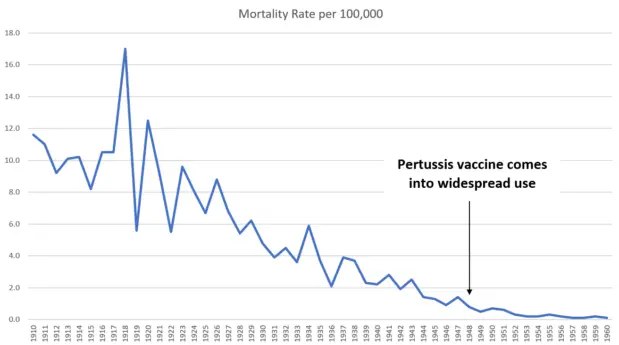
As you can see, the belief that the vaccine was responsible for the dramatic decline in deaths from whooping cough is categorically false. It is a myth attributable to what we may appropriately refer to as the vaccine religion.
At the time Dauer was writing the Public Health Reports paper, in 1943, whooping cough caused 2.5 deaths per 100,000 population—a dramatic decline of nearly 80 percent from the 11.6 deaths per 100,000 reported for 1910. By 1946, the year prior to the AAP’s recommendation for routine use of the DTP vaccine, the rate was 0.9 per 100,000—a decline of more than 90 percent that cannot be attributed to vaccination.
Did the Vaccine Contribute to Declining Pertussis Mortality?
However, the argument could still be made that the vaccine contributed to the already decreasing mortality. This is not the least bit evident from the data graphed above, but that data was not age-stratified, so any contribution of the vaccine with respect to infant deaths might not be noticeable.
Indeed, my quick Google search for historical data also turned up a paper by Edward Mortimer and Paul Jones titled “An Evaluation of Pertussis Vaccine”, published in Review of Infectious Diseases (now Clinical Infectious Diseases) in 1979, which made precisely that argument: that the vaccine accelerated the decline in mortality among infants.
By 1979, pertussis was “no longer a major cause of death in infants in the United States.” It was “tempting”, the authors wrote, “to ascribe the remarkable reductions in morbidity and mortality from pertussis in the United States to the widespread use of this killed whole-bacterial vaccine. However, mortality from pertussis in the United States declined from 1900 through 1939, before the development of effective vaccines that were widely used.”
Note that this implies that the vaccine became widely used from 1940 onward, which we have already established to be untrue. This is important, so keep it in mind.
Continuing, Mortimer and Jones quote Dauer’s observation that it would be “extremely difficult” to show that the vaccine “had any effect in reducing mortality from whooping cough” given the dramatic decline that had already occurred prior to its widespread use. The reasons for this decline were “not clear” but may have included “changes in socioeconomic status”, “better nutrition”, and “some unknown change in the organism”.
Coming to the central conundrum, they wrote (emphasis added):
In spite of the fact that a striking reduction in mortality from pertussis occurred before the development of pertussis vaccine, most physicians consider the vaccine to have made a major contribution to the subsequent, further decrease in mortality. However, the data . . . indicate the lack of absolute proof that the decline in mortality from pertussis in the United States is a consequence of the use of the vaccine.
Note that this is an extreme understatement. It’s not that the data doesn’t absolutely prove that the vaccine was responsible but that it provides no evidence to support that belief at all.
The “doubts” about the vaccine’s impact on the reduction in mortality, they continue, were “coupled with concerns about untoward reactions to the vaccine”, including those of a “neurologic” variety, such as “a strange shocklike syndrome”, “excessive somnolence”, “convulsion”, and “gross encephalopathy”.
The question the authors sought to address was “whether pertussis vaccine is now superfluous in view of the evidence that socioeconomic and other factors are major contributors to the decline in mortality from pertussis in the United States and Britain, and particularly in view of the alleged toxicity of the vaccine.”
Since a randomized controlled trial was deemed “ethically impossible” due to vaccination having already become standard medical practice on the assumption that it was safe and effective, “the question of whether the use of pertussis vaccine is currently superfluous can be answered only indirectly by circumstantial evidence.”
Note that the idea that to conduct a proper study for safety and effectiveness that includes examining the vaccine’s effect on mortality would be “unethical” because it would deprive the control group of the supposed benefits of the vaccine rests on the fallacy of begging the question. It also leads to the absurd corollary that it is ethical to instead treat the entire population as subjects of a mass uncontrolled experiment without informed consent.
Searching for circumstantial evidence of a positive impact of the vaccine, they limited their analysis to children at higher risk: “infants younger than one year of age and children from one to four years of age.” They presented consecutive five-year periods from 1900 through 1974 for each age group, from which data “it is clear that the decline in mortality from pertussis accelerated in the 1940s.”
Instructively, they observed that the difference for children aged one to four years was “not statistically significant.” In other words, the DTP vaccine admittedly made no significant contribution to the reduction in mortality among children aged one to four years.
“The mortality slope for infants younger than one year of age for successive five-year periods during 1940–1954”, however, was “significantly steeper than that for 1930–1939.” This “considerable acceleration in the previously observed decline in mortality from pertussis” was “concomitant with the development and widespread use of pertussis vaccine.”
In other words, they found an association that could potentially be attributed to the vaccine.
Noting that federal regulations for the standardization of pertussis vaccine were not established until the early 1950s, they presented the following graph to make that case, to which I have added the blue and red text box and the red arrow to indicate the approximate year that the DTP vaccine came into widespread use:
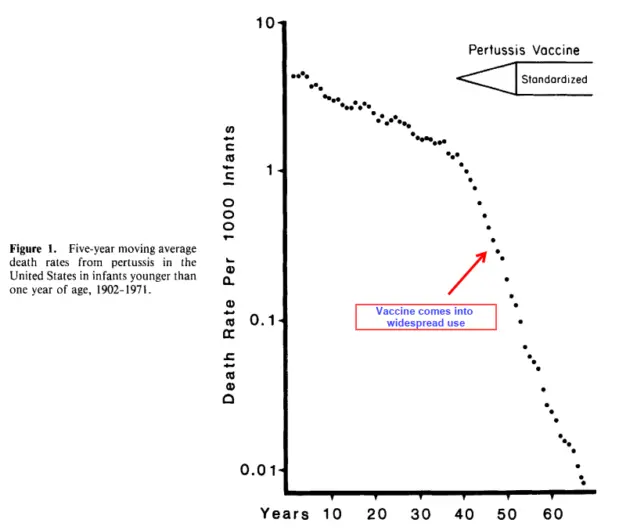
Notice that they attribute the accelerated decline from 1940 onward to the pertussis vaccine even though, as we’ve already established, it did not come into widespread use until near the end of the decade. Their graph suggests that the vaccine was introduced in 1940, but, again, that is untrue—an arbitrarily selected date that suits their argument but doesn’t accord with the documentary record.
Again, pertussis vaccines had been around since the early 1900s, with the first licensing of such a vaccine occurring in 1914, but they were not widely used; it was not until 1944 that pertussis vaccine was reinstated in the AAP’s New and Nonofficial Remedies and recommended for routine use; it was not until 1947 that the AAP recommended the DTP vaccine; and it was not until 1948 that the pertussis vaccine came into widespread use.
Notice also that Mortimer and Jones also used an exponentially decreasing scale for the vertical axis, with each point on the axis representing a tenfold decrease from the one above it.
So, I decided to graph the data they present for myself to see what it showed. Here is their data table showing the mortality rate for consecutive five-year periods:
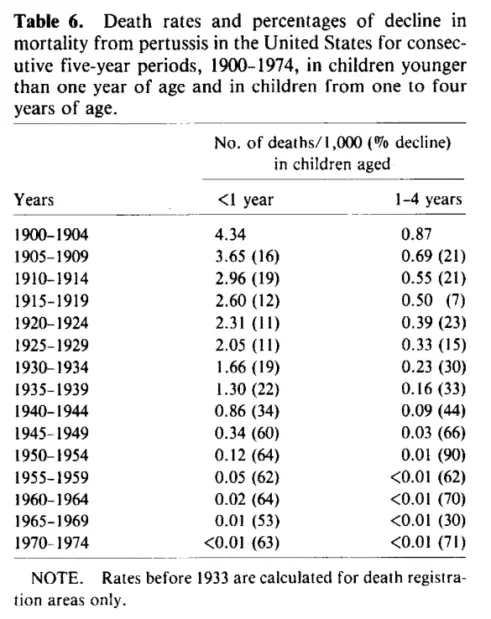
Entering that data into Excel, here is the result:
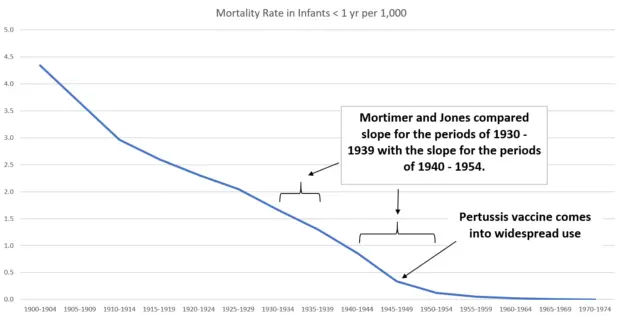
What this graph should make immediately obvious is that Mortimer and Jones cherry-picked data to support their argument that the accelerated decrease in pertussis mortality in infants could be attributed to the pertussis vaccine.
First, notice that the slope from the three five-year periods from 1900 through 1914 is clearly also steeper than the two five-year periods from 1930 through 1939, yet that decrease obviously cannot be attributed to the use of pertussis vaccine. Hence, vaccination is not required to explain the steeper slope for the periods from 1940 through 1954. This could just as well be due to natural variability in the decrease.
Second, notice that, while the slope was less steep again for the periods from 1910 through 1929, the acceleration in the rate of decrease that includes the 1940s began during the second half of the 1920s. That is, while Mortimer and Jones claim that the accelerated decline coincided with the widespread use of the vaccine, that overall trend had begun decades earlier.
Third, notice again that they suggested that the steeper slope for the period of 1940 through 1944 was attributable to the vaccine even though the vaccine did not come into widespread use until the period of 1945 through 1949. This is obviously nonsensical.
Fourth, notice that, within the ostensibly post-vaccine period they compare with the pre-vaccine period, the slope was steeper in the first half of the 1940s before the vaccine was widely used and flattened out after the introduction of the DTP vaccine—precisely the opposite of the impression they had sought to create by including the full decade of the 1940s as though mass vaccination with the DTP vaccine had begun in 1940.
By their own logic, therefore, and using their own data, we could argue that mass vaccination impeded the decrease in pertussis mortality in infants. We can’t conclude that, of course, because their logic is fallacious, and a decrease in the rate of decrease is what we would expect as the death rate approaches zero. What we can conclude, though, is that their argument that the DTP vaccine accelerated the decrease in pertussis mortality is dependent on disingenuous statistical wizardry.
Setting that aside, they acknowledged—once again understatedly—that the change they observed “cannot be attributed with certainty to the vaccine.”
They also acknowledged that the DTP vaccine was “relatively crude, consisting of whole, killed organisms and undoubtedly containing many antigens and toxic moieties.”
Indeed, that is why it was eventually phased out in the US and other developed countries and replaced with the DTaP vaccine, which includes an acellular rather than whole-cell pertussis component.
The Heresy of Questioning Foundational Myths of the Vaccine Religion
The belief that the decline in pertussis and other infectious disease mortality was attributable to vaccines was discussed in a paper by John McKinlay and Sonja McKinlay titled “The Questionable Contribution of Medical Measures to the Decline of Mortality in the United States in the Twentieth Century”, published in The Milbank Memorial Fund Quarterly: Health and Society in 1977.
Prefacing their article with the recognition that what they were about to say was considered “modern ‘heresy’”, they set out to challenge the belief that specific medical interventions were “the major reason for most of the modern (twentieth century) decline in mortality.”
They cited the prior work of Thomas McKeown, who in 1975 had concluded, with respect to the decline in infectious disease mortality in England and Wales during the second half of the nineteenth century, that “the main influences were: (a) rising standards of living, of which the most significant feature was a better diet; (b) improvements in hygiene; and (c) a favorable trend in the relationship between some micro-organisms and the human host.” This trend continued through the twentieth century.
McKinlay and McKinlay observed that, “Not surprisingly, those which challenge prevailing myths or beliefs are subject to the most stringent methodological and statistical scrutiny, while supportive studies, which frequently employ the flimsiest impressionistic data and inappropriate techniques of analysis, receive general and uncritical acceptance.”
Unintimidated by the prevailing fundamentalism within the medical establishment, they proceeded to challenge to mainstream paradigm. Here is a graph they present showing the dramatic decline in mortality in the US throughout the twentieth century:
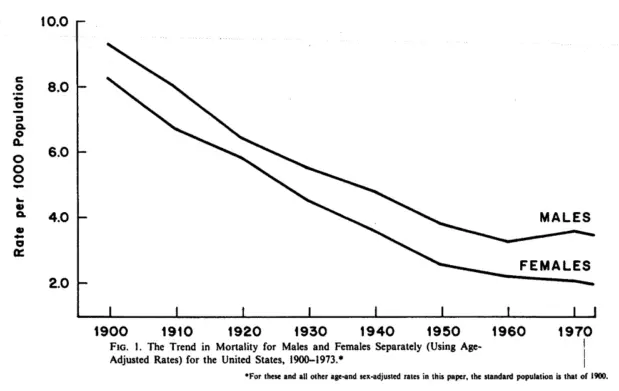
They also presented a graph showing the decrease in mortality “reduced by the number of deaths attributed to the eleven major infectious conditions (typhoid, smallpox, scarlet fever, measles, whooping cough, diphtheria, influenza, tuberculosis, pneumonia, diseases of the digestive system, and poliomyelitis).” This graph also showed “the increase in the proportion of the Gross National Product expended annually for medical care”:

As they comment, it is clear that “A major part of the decline in deaths from these causes since about 1900 may be attributed to the virtual disappearance of these infectious diseases.” The graph also shows the “absurdity” that “the beginning of the precipitate and still unrestrained rise in medical care expenditures began when nearly all (92 percent) of the modern decline in mortality this century had already occurred.” (The emphasis is theirs.)
At the same time, there had been an increase in the proportion of deaths contributed by heart disease, cancer, and stroke, from about 16 percent in 1900 to 58 percent in 1973, which they showed in the following graph:
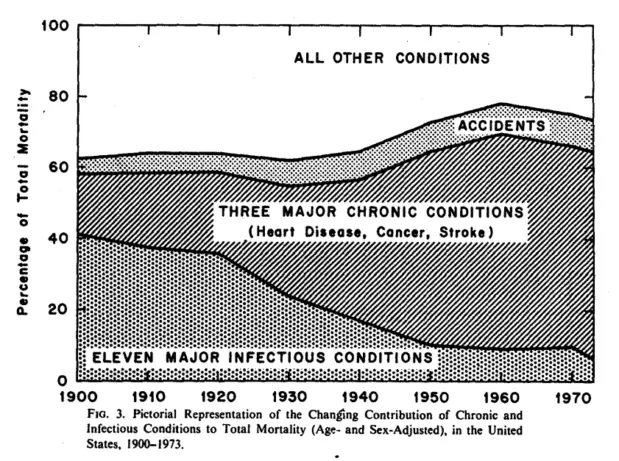
Clearly, this represents an abysmal failure of the medical establishment and public health policies.
For pertussis, they observed that the data exhibit a relatively smooth mortality trend that is “unaffected by the medical measures” that had been introduced—namely, the DTP vaccine. Here are graphs that they present showing how mortality was already dramatically declining for pertussis and other infectious diseases before the introduction of the medical interventions we are supposed to believe were responsible for the declines (I’ve outlined the graph for pertussis in red; note that they are giving the vaccine the benefit of the doubt by identifying the introduction of the vaccine as occurring in approximately 1930 as opposed to the late 1940s when its use became widespread):
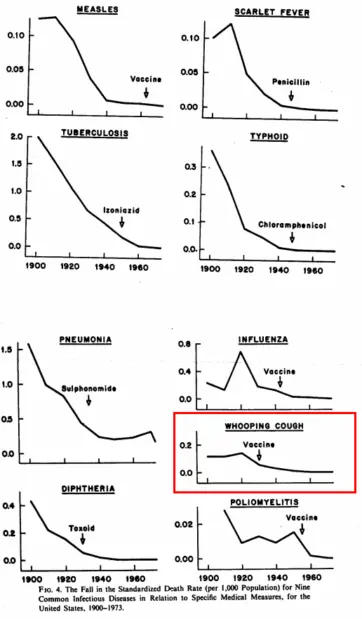
For whooping cough, diphtheria, influenza, and pneumonia, four diseases “for which the decline in mortality appears substantial after the point of intervention”, even “on the unlikely assumption that all of this decline is attributable to the intervention—it is estimated that at most 3.5 percent of the total decline in mortality since 1900 could be ascribed to medical measures introduced for the diseases considered here.”
Despite their attempt “to dispel the myth that medical measures and the presence of medical services were primarily responsible for the modern decline in mortality”, three decades later, that foundational myth of the vaccine religion was reiterated in the aforementioned New York Times article, just as it is commonly repeated elsewhere by the mainstream media to this day.
While perhaps a “heresy” within the medical community in 1977 and still certainly heretical in the public discourse today, the fact that vaccination was not the cause of the dramatic declines in infectious disease mortality witnessed during the twentieth century is completely uncontroversial within the scientific literature.
For instance, a paper titled “Annual Summary of Vital Statistics: Trends in the Health of Americans During the 20th Century”, published in Pediatrics in 2000, acknowledges that “nearly 90% of the decline in infectious disease mortality among US children occurred before 1940, when few antibiotics or vaccines were available.”
Confirming that the pertussis vaccine became “only widely used in routine pediatric practice after World War II”, the paper reiterates that “vaccination does not account for the impressive declines in mortality seen in the first half of the century.”
The DTP’s Negative Impact on Childhood Mortality
In light of the scientific data, consider now again the statement by the New York Times that, “Before the 1940s when a pertussis vaccine for children was introduced, whooping cough was a leading cause of death in young children.”
That statement is technically true, but it falls easily within Merriam-Webster’s second definition of a “lie”, which is “to create a false or misleading impression”. It is deceit by omission.
The conclusion we are supposed to draw is that the vaccine was responsible for the dramatic reduction in deaths from whooping cough seen after the vaccine came into widespread use in the late 1940s. What the Times declines to inform readers is that most of that reduction occurred before the introduction of the DTP vaccine, and there is no reason to believe that trend would not have continued had there never been a vaccine.
But that’s not all.
As already mentioned, randomized, placebo-controlled trials to determine the vaccine’s effect on mortality were never done. Hence, to examine that question, researchers have relied on observational studies. While the whole-cell pertussis vaccine was replaced in the US and other developed countries with an acellular pertussis vaccine (DTaP), the DTP vaccine is still the most widely used vaccine in the world, and studies have consistently shown it to be associated with an increase in childhood mortality.
It’s not that children who receive the pertussis vaccine are more likely to die from pertussis. Instead, the vaccine appears to detrimentally affect children’s immune systems in such a way as to make them more vulnerable to other diseases.
As the leading researchers into what are called “non-specific effects” of vaccines bluntly summarized in a 2017 research paper published in EBioMedicine, “All currently available evidence suggests that DTP vaccine may kill more children from other causes than it saves from diphtheria, tetanus or pertussis. Though a vaccine protects children against the target disease it may simultaneously increase susceptibility to unrelated infection.” (Emphasis added.)
The observed effect is of such a magnitude that the DTP vaccine has been “associated with 5-fold higher mortality than being unvaccinated.” This effect is particularly pronounced among girls.
Of course, you won’t learn about that scientific data, either, by reading the thought-controlling New York Times or other mainstream media.
It would be one thing if faithful adherents to the vaccine religion merely clung to their beliefs without harming anyone. But given how they manufacture consent for vaccination through fraud and deception and advocate the use government force to coerce parents into compliance with the CDC’s routine childhood vaccine schedule, manufacturers of which vaccines have legal immunity against injury lawsuits, they must be considered members of a dangerous cult whose anti-science nonsense must be confronted and exposed.
The good news is that they are losing control of the narrative. We are winning because we have truth on our side. The need to prevent the masses from learning the truth is precisely why they are resorting to outright censorship, including the hypocritical use of supposed “Fact Check” articles to spread their own misinformation and political propaganda (incontrovertible examples of which I’ve documented here, here, here, and here.)
This is not to say there isn’t misinformation from what they dub the “anti-vaccine” side of the debate. There certainly is. But the preponderance of misinformation is spread by the government and mainstream media. Instructively, no matter how egregious and obvious the lies, you won’t ever see Facebook flagging “pro-vaccine” posts as “misinformation”. The conclusion is inescapable that the thought-controllers have no problem at all with the spread of misinformation as long as it is conducive to the political agenda of increasing vaccination rates.
The fear of the public learning the truth about what science really tells us about vaccines is why Congressman Adam Schiff instructed Facebook, Google, and Amazon to censor what he called vaccine “misinformation”, his euphemism for any information, no matter how factual, that might lead parents to conclude that strictly complying with the CDC’s recommendations might not be in the best interests of their child.
It’s why propagandists masquerading as scientists and journalists equate any information that doesn’t serve the policy goal of increasing vaccination rates is dubbed “anti-vaccine” and mindlessly equated with “misinformation”, such that even the simple act of saying that we have a right to informed consent is now being regarded as a heresy that must not be permitted on social media.
They are fighting for dystopian authoritarianism. We must fight back to create a brighter future for humanity. Do your own research. Think for yourself. Empower yourself with knowledge. Stand up and speak out. The health and liberty of ourselves, our children, and future generations is at stake.
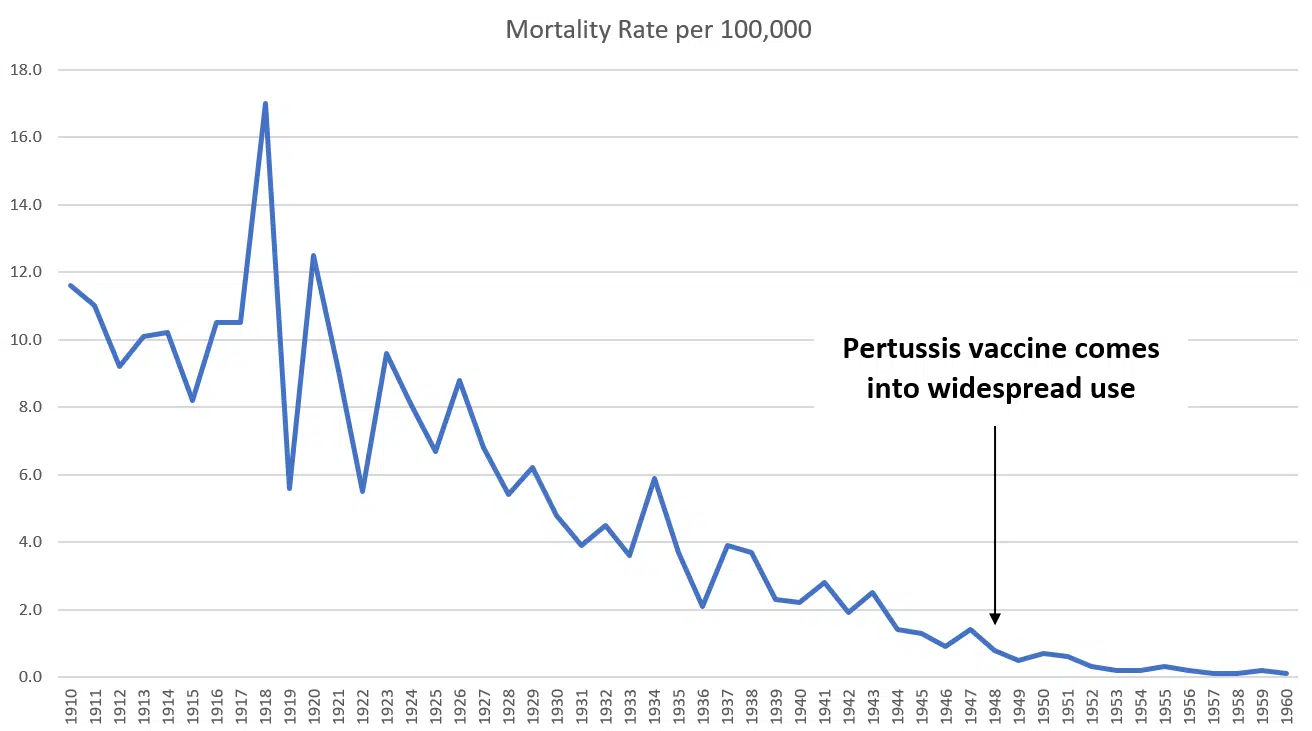



Bravo! Thank your for your excellent, in-depth investigative journalism!
Hi Bernadette! Thanks for the feedback.
Great article. I will bookmark this one for its high quality source information
Great research, very thorough. I am an MD looking into this topic and noted your chart on pertussis mortality from 1910 taken from “Vital Statistics Rates in the United States, 1940–1960”, by Robert D. Grove and Alice M. Hetzel of the National Center for Health Statistics – I could not find pertussis mortality in that document. Do you have a page number that you found from which you made your Excel graph?
Btw, I’m reading your book The War on Informed Consent now – very interesting and spurring me to learn more.
Hi John,
Thanks for your interest in my work. Here again for anyone reading the comments is the link to the vital statistics:
https://www.cdc.gov/nchs/data/vsus/vsrates1940_60.pdf
Data on pertussis mortality starts at p. 559 (p. 565 of the PDF), Table 65, labeled as “whooping cough”. Hope that helps!